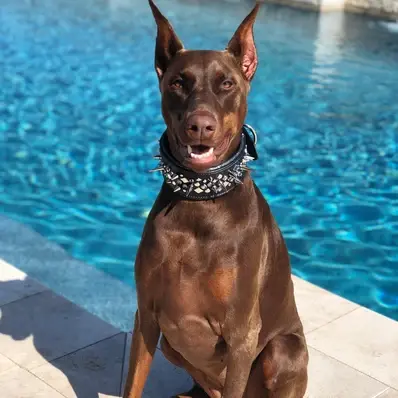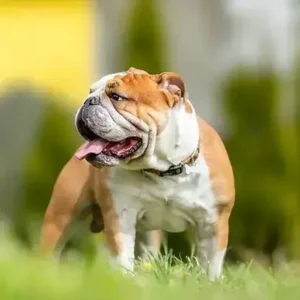Doberman History/Origin
In the late 19th century, Louis Doberman, a tax collector in Apolda, Thuringia, Germany, sought protection during his dangerous rounds. As the town’s dogcatcher, he began breeding dogs to create a loyal companion and protector, leading to the inception of the early Doberman Pinscher.
However, the specific breeds used in the mix remain uncertain, with speculation including the Rottweiler, German Pinscher, and Black and Tan Terrier.
The Doberman Pincher made its debut in 1876 and received a favorable reception. When Louis Doberman passed away in 1894, the lineage of the breeds used in its creation was lost, resulting in the dog breed being named in his honor. German breeders at the time prioritized functionality over appearance, striving to develop the Doberman into a highly capable “super dog.”
Otto Goeller, a breeder, played a pivotal role in refining the Doberman into a more trainable and practical dog. In 1900, the German Kennel Club officially recognized the Doberman Pinscher as a distinct breed. By 1908, the Doberman had made its way to the United States.
One of the earliest Dobermans shown in conformation reportedly won “Best in Show” honors at three consecutive events. This achievement occurred despite someone daring to check the dog’s teeth before the shows.
Doberman History- Source: Doberman Forum
The establishment of the Doberman Pinscher Club of America in 1921 and the adoption of the breed standard written in Germany a year later marked significant milestones. The subsequent 15 years were crucial for the Doberman’s development, as economic hardships during World War I led to a decline in Dobermans in Europe.
Breeding was restricted to the best dogs, mainly owned by the military, police, and affluent individuals. Post-1921, top German sires and offspring were imported to the United States.
With the outbreak of World War II, the Doberman Pinscher faced jeopardy again in Germany, but earlier importations had already secured the breed in the United States. In the mid–1900s, both Germans and the British dropped the word “Pinscher” from the breed name.
The American Kennel Club (AKC) recognizes the Doberman under the Working Group.
Over time, breeders successfully tempered the original Doberman’s sharp personality, resulting in a guard dog known for being protective, affectionate, and loyal to its family.
Doberman Personality
The Doberman is known for its remarkable personality traits, combining intelligence, energy, loyalty, and playfulness. Within the family unit, these purebred dogs demonstrate unwavering loyalty and affection, often forming strong bonds with their human companions.
Their innate protective instincts make them vigilant guardians, quick to respond to any perceived threats to their loved ones.
- Temperament
Dobermans possess a temperament characterized by intelligence, alertness, and adaptability. They are highly intelligent dogs, capable of learning quickly and mastering various commands and tasks. Their alert nature makes them excellent watchdogs, as they are always vigilant and quick to alert their owners to any potential intruders or unusual occurrences. Additionally, they are adaptable to various living situations, whether in a bustling urban apartment or a spacious suburban home.
- Potential Challenges
While Dobermans are known for their intelligence and loyalty, they may present certain challenges that owners should be aware of. One potential challenge is their need for regular mental and physical stimulation. Due to their high energy levels and intelligence, they require ample exercise and mental enrichment to prevent boredom and destructive behavior. Additionally, their protective instincts may manifest as territorial behavior, especially if not properly socialized from a young age.
Moreover, their strong-willed nature and intelligence may lead to stubbornness and independence if not met with firm and consistent leadership from their owners. Doberman owners must provide structured training, socialization, and positive reinforcement to address these potential challenges effectively.
Doberman Physical Appearance
The Doberman Pinscher is a medium-sized, square-bodied dog with smooth muscles and an elegant appearance. It has a wedge-shaped head with high-set ears that can be cropped or left natural. Its naturally arched neck transitions smoothly into the shoulders, leading to a strong, straight topline that extends to a tail, which appears as a continuation of the spine.
- Size
The Doberman Pinscher typically stands 26 to 28 inches tall at the shoulder. Their weight ranges from 70 to 100 pounds. This size contributes to their strong presence.
- Coat color
The Doberman Pinscher has a sleek, smooth coat that lies close to the skin. Their coat comes in black, red, blue, and fawn colors, often featuring rust markings on specific areas. This distinct coloration adds to their striking appearance.
Black Doberman – Source: Pixabay
Black and Tan Doberman – Source: Pixabay
Brown Doberman – Source: Britannica
Doberman Gender Differences
The differences in Dobermans’ genders mainly involve size and temperament. It’s important to remember that these variations are general tendencies and should not lead to stereotyping. Each Doberman, regardless of gender, has its unique personality.
- Size differences
Male Doberman Pinschers typically have an average height of 26–28 inches and weigh between 75–100 pounds. Female Dobermans are slightly smaller, with an average height of 24–26 inches and a weight range of 60–90 pounds.
- Temperament differences
Male Dobermans are often more protective and territorial than females. They can be more assertive and dominant, sometimes showing a bit more stubbornness in training. Males may also be more playful and energetic, often enjoying more physical activities and roughhousing.
On the other hand, female Dobermans tend to be more affectionate and easier to train. They can be more attentive and responsive to their owners, making them excellent companions. Females might be slightly less territorial and protective than males, but they are still very loyal and dedicated to their families
Doberman Feed/Nutrition
Feeding a Doberman Pinscher typically involves providing 2.5 to 3.5 cups of high-quality dry food per day, divided into two meals. The exact amount depends on factors like the dog’s size, age, build, metabolism, and activity level, as each dog has unique dietary needs.
An active dog will likely require more food than a less active one. Opting for higher-quality food ensures better nourishment, meaning less quantity is needed to meet their nutritional requirements. You can also incorporate oranges as a healthy treat, as they are rich in vitamin C and fiber.
To maintain your Doberman’s health, it’s recommended to measure their food and feed them twice a day rather than leaving food out all the time.
Doberman Health
Doberman Pinschers are generally healthy dogs with a strong constitution. However, like all breeds, they can be prone to certain health conditions. Potential owners need to be aware of these health problems to ensure responsible ownership. While not every Doberman will experience these issues, being informed and vigilant about their well-being is crucial.
- Von Willebrand’s Disease: An inherited blood disorder that impairs clotting, leading to excessive bleeding after injury or surgery. Symptoms include nosebleeds, bleeding gums, and internal bleeding. Though there’s no cure, blood transfusions from healthy dogs can help manage it. Dogs with this condition should not be bred.
- Hip Dysplasia: A hereditary condition where the thighbone doesn’t fit properly into the hip joint. Some dogs experience pain and lameness in the rear legs. X-ray screening is the definitive diagnostic method. Dogs with hip dysplasia should not be bred.
- Progressive Retinal Atrophy: A group of eye diseases causing gradual retina deterioration, resulting in night blindness and daytime vision loss. Many dogs adapt well to limited vision if their surroundings remain familiar.
- Hypothyroidism: A thyroid disorder linked to epilepsy, hair loss, obesity, and skin conditions. Treatment involves medication and dietary adjustments.
- Albinism: A genetic condition resulting in pink skin, nose, and light eyes. Albino dogs are sensitive to sunlight and susceptible to health issues, including cancer and eye problems. Albino dogs should not be bred.
- Dilated Cardiomyopathy: A heart muscle disease causing thinning and weakening, leading to an enlarged heart and eventually heart failure. Treatment includes oxygen, fluid management, and medication.
- Canine Gastric Torsion: A life-threatening condition, particularly in deep-chested breeds like Dobermans, caused by stomach distention and twisting. Immediate veterinary attention is critical. Signs include a distended abdomen, excessive salivation, retching, and weakness.
Regular veterinary check-ups and preventive measures are crucial to avoid these diseases and maintain a Doberman Pinscher’s health. Proper care and early detection can significantly increase the dog’s life expectancy and overall well-being.
Doberman Care and Grooming
Proper care for Doberman Pinschers involves providing them with ample space for exercise and play in a suburban or country setting. Daily exercise is essential due to their high energy levels.
A securely fenced yard ensures their safety and that of others. These high-energy dogs require at least 60-90 minutes of daily exercise. They thrive when considered part of the family, participating in all activities.
Socialization early in life and training are crucial for their well-rounded development. Exposure to various people, animals, and experiences shapes positive behavior. Being considerate of others’ comfort when encountering Dobermans in public is important.
Their sleek coat comes in various colors and requires minimal grooming. Weekly brushing and occasional baths suffice. Dental care, nail trims, and ear checks are essential parts of their grooming routine.
Regular examinations help identify health issues early, ensuring their well-being. Additionally, leash training your dog is important for walks and outings, ensuring good behavior and safety.
Doberman Rescue Groups
Rescue groups specializing in Doberman Pinschers are dedicated to rehoming and caring for these dogs in need. They provide shelter, veterinary care, and rehabilitation to ensure the well-being of rescued Dobermans. Adopting from a rescue group offers a second chance for these dogs to find loving forever homes.
Doberman Pinscher Price
The price of a Doberman Pinscher typically ranges from $1,000 to $2,500, depending on factors such as breeder reputation, pedigree, and location.
When considering purchasing a Doberman Pinscher, it’s essential to find reputable breeders who prioritize ethical breeding practices. Responsible breeders focus on the health, temperament, and well-being of the dogs, conducting health screenings and genetic testing to ensure the puppies are healthy.
Interesting Facts
- The Doberman breed was named after its creator, Karl Friedrich Louis Dobermann, a German tax collector, security guard, and police officer. Dobermann felt the need for a protective companion during his rounds, leading to the development of the breed.
- During World War II, Doberman Pinschers were highly favored by the U.S. forces, comprising about three-quarters of all service dogs. This popularity even surpassed that of German Shepherds, which accounted for the remaining 25%.
- The Doberman Pinscher has played a role in Disney’s live-action comedy film Beverly Hills Chihuahua as El Diablo.
Best For
The Doberman Pinscher is best suited for individuals or families looking for a loyal, protective, and energetic companion. They thrive in environments where they receive ample exercise, mental stimulation, and consistent training. Their loyalty and protective nature make them excellent guardians, while their affectionate demeanor makes them cherished members of the family.
Top Names
| Male Doberman Names | Female Doberman Names |
| Zeus | Athena |
| Max | Bella |
| Duke | Luna |
| Rocky | Daisy |
| Titan | Sasha |









 Rottweiler- Source:
Rottweiler- Source:  German Pinscher – Source:
German Pinscher – Source:  Doberman History- Source:
Doberman History- Source: 

 Black Doberman – Source:
Black Doberman – Source:  Black and Tan Doberman – Source:
Black and Tan Doberman – Source:  Brown Doberman – Source:
Brown Doberman – Source: 








